|
|
|
Sort Order |
|
|
|
Items / Page
|
|
|
|
|
|
|
| Srl | Item |
| 1 |
ID:
140561
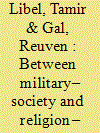

|
|
|
|
|
| Summary/Abstract |
The growing religiosity in the Israel Defense Forces (IDF) in recent years is discussed by employing the broader lens of changes to the organization's overall manpower. First, the authors will indicate the dynamic and changing make-up of those serving in the IDF, in terms of both the socio-demographic characteristics of conscripted soldiers, and the motivation of individuals enlisting in the IDF. Second, it is demonstrated how a window has opened in the IDF, especially in combat units and command roles, for a growth in religiosity as a result of the gradual increase in the number of conscripts affiliated with the Zionist national-religious population.
|
|
|
|
|
|
|
|
|
|
|
|
|
|
|
|
| 2 |
ID:
141414
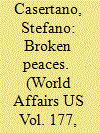

|
|
|
|
|
| Summary/Abstract |
Oslo is history. Twenty years have passed since the last significant peace accord between the Israelis and the Palestinians. The intervening years have been marked by an intifada and three military interventions in Gaza by the Israel Defense Forces that have left around seven thousand Palestinians and one thousand Israelis dead. The so-called “Peace Process” is in tatters and there seems to be no way of re-stitching it.
|
|
|
|
|
|
|
|
|
|
|
|
|
|
|
|
| 3 |
ID:
111153
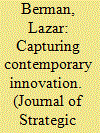

|
|
|
|
|
| Publication |
2012.
|
| Summary/Abstract |
The question of what enables some militaries to innovate effectively is of great interest to both scholars and commanders. However, the traditional models of military innovation fail to capture the complex innovation process. This study develops a new analytical framework that examines the pressures on and incentives for military innovation in the international, civil/military, organizational, and cultural planes and uses it to evaluate Israel Defense Forces (IDF) innovation between 2000 and 2009. Based on interviews with Israeli commanders and extensive research in Israel, this work finds that the IDF struggled to innovate before the 2006 war against Hizballah, but innovated effectively after the conflict once military and civilian leaders understood threats similarly. New models are needed to analyze the contemporary multi-dimensional innovative process.
|
|
|
|
|
|
|
|
|
|
|
|
|
|
|
|
| 4 |
ID:
118539
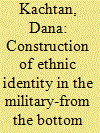

|
|
|
|
|
| Publication |
2012.
|
| Summary/Abstract |
This article examines how ethnicity is created, maintained, and perpetuated in the Israel Defense Forces (IDF). Research studies on ethnicity in the Israeli army have examined ethnicity while focusing on the macro, emphasizing the way the structure and the policy of the army, alongside its reciprocal relations with the greater society and the state, maintain and reproduce ethnicity. It focuses on the micro point of view, hitherto neglected, which emphasizes the soldiers' experience and interpretation. Using a case study of two Israeli infantry brigades, the article demonstrates how ethnicity is produced, maintained, and reproduced by individuals through practices, behavior, perceptions, and observations.
|
|
|
|
|
|
|
|
|
|
|
|
|
|
|
|
| 5 |
ID:
159441
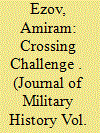

|
|
|
|
|
| Summary/Abstract |
The crossing of the Suez Canal by the Israel Defense Forces (IDF) during the Yom Kippur War of October 1973 encompassed the toughest and bloodiest battles that the IDF had ever known. Because of the characteristics of the forces and missions involved, it was the ultimate expression of a multi-dimensional battle. During the campaign, there were battles to achieve breakthrough and approach clearing, armor versus armor battles, water obstacle crossings, bridging, establishment of a bridgehead, all featuring complicated logistics. Most of the branches of the IDF became involved and a full range of combat apparatus was deployed, including some items which had not been fully developed and on which training had not been suitably completed. The central problem of the crossing campaign was the “orchestration” of new fighting materials—the means to achieve a water crossing—into a battle that had not been foreseen. Alongside organization, fighting doctrine, and training, this kind of orchestration also demanded innovative leadership and command and control, effective communications, and the ability to cope with a complex and unexpected battlefield. The aim of this article is to test and compare the objectives, planning, and execution of two crossing campaigns—that of the Egyptian Army and that of the IDF. The differences in doctrine stemmed from the choice of strategic objectives and from the adoption of differing combat doctrines.
|
|
|
|
|
|
|
|
|
|
|
|
|
|
|
|
| 6 |
ID:
128052
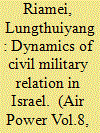

|
|
|
|
|
| Publication |
2013.
|
| Summary/Abstract |
Israel was founded in 1948 in the midst of war and hardship, a period personified by the brave men and women driven by a sense of historic mission to risk everything to protect Jewish lives from assault and military attack. The generation that fought for a Jewish state also had to structure government activities that demand a different kind of boldness in a context tested not by first power but by competing interest goals. Since the creation of the state of Israel, the Jewish population has been defined by military Service. The Israeli citizen was ultimately there to serve in its war against the Arab world, Despite recurrent wars and a perpetual state of alert, Israel has profoundly failed to become a military state. Israel is the only post-World War II democracy in the world that has been in a state of constant war with its neighbours.
|
|
|
|
|
|
|
|
|
|
|
|
|
|
|
|
| 7 |
ID:
144728


|
|
|
|
|
| Summary/Abstract |
The paper’s main argument is that Israel’s security policy, which traditionally focused on defending its territorial integrity against regular Arab armed forces, was, by the 2010s, transformed into one that focuses on facing a variety of state- and non-state-based threats. Neo-realist explanations could neither account for the contested nature of the security debate during this period, nor the inconsistent evolution of the policy. The present study aims to solve this conundrum by introducing an alternative approach known as 4th generation strategic culture research. The paper is comprised of four parts. First, the origins and evolution of strategic culture are reviewed, with emphasis placed on the commonly accepted weaknesses that, to date, have prevented it from being used as a testable theoretical concept, and subsequently as an explanatory factor for security policy changes. The second part presents the “modernist constructivism” approach that bridges the gap between traditional constructivism and hypothesis-driven research design. Next, the paper introduces the emerging fourth generation in strategic culture literature, followed by a conceptual framework designed to resolve the inherent weaknesses of the more traditional approaches. Finally, this conceptual framework is applied to analyse the transformation of Israel’s security policy between 1982 and 2014.
|
|
|
|
|
|
|
|
|
|
|
|
|
|
|
|
| 8 |
ID:
131044
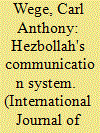

|
|
|
|
|
| Publication |
2014.
|
| Summary/Abstract |
During the two generations of Hezbollah's existence the organization has grown from a clan-based network of terrorist cells to the most important stakeholder in the Lebanese polity. Its communication architecture evolved concurrently with the larger Hezbollah organization. The trajectory of Hezbollah's communications architecture has been in the direction of increasingly sophisticated communications and the need to transmit greater volumes of information securely across a growing organization.
|
|
|
|
|
|
|
|
|
|
|
|
|
|
|
|
| 9 |
ID:
118987
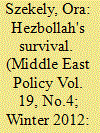

|
|
|
| 10 |
ID:
189737


|
|
|
|
|
| Summary/Abstract |
The Israel Defense Forces (IDF) have been at war with Hizbullah and Hamas, two powerful non-state actors, several times throughout Israel’s history. In the next war, the IDF will seek to gain a decisive and quick victory, by launching a large-scale offensive, and strive to destroy military targets, such as rockets. It will continue to rely heavily on firepower, mostly from the air, while carrying out a limited manoeuvre on the ground to reduce its casualties. Yet, Ehud Eilam argues, a massive ground offensive might be needed with such a buildup being based on the air force, infantry and intelligence.
|
|
|
|
|
|
|
|
|
|
|
|
|
|
|
|
| 11 |
ID:
123875


|
|
|
|
|
| Publication |
2013.
|
| Summary/Abstract |
Since 1950, the Israel Defense Forces has operated the Galei Tzahal radio station, which broadcasts to the general public. Over the years, substantial changes have taken place in the station's programming, as it grew from a marginal broadcasting body into a major radio station with high ratings. This study examines a particular aspect of the station's history-its imagined audience-and the fundamental changes in the perception of that audience over time.
|
|
|
|
|
|
|
|
|
|
|
|
|
|
|
|
| 12 |
ID:
115345
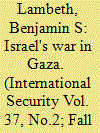

|
|
|
|
|
| Publication |
2012.
|
| Summary/Abstract |
For more than two decades, the pursuit of "lessons learned" from major combat encounters has been an area of sustained activity within the defense establishments of the United States and its principal allies around the world. Yet as often as not, such efforts have, at best, yielded lessons merely indicated and identified, since they cannot be said to have been truly learned until their prescriptions have been accepted and assimilated into an armed service's doctrine, force development, and operating procedures. In one notable instance in late December 2008 and early January 2009, however, an exemplar of lessons learned and incorporated was offered by the twenty-three-day campaign conducted by the Israel Defense Forces (IDF) against the radical Islamist organization Hamas in the Gaza Strip. That performance came on the heels of the IDF's less impressive showing more than two years before against the Iranian-sponsored terrorist movement Hezbollah during Israel's 2006 war in Lebanon. By any measure, Israel's comparative success in Gaza was a direct result of teachings gained and duly incorporated into the IDF's combat repertoire by Israeli civilian and military leaders in response to their earlier misadventure in Lebanon.
|
|
|
|
|
|
|
|
|
|
|
|
|
|
|
|
| 13 |
ID:
175125
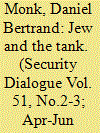

|
|
|
|
|
| Summary/Abstract |
Histories of the Arab–Israeli War of 1967 have advanced a curious commonplace. As they have sought to account for the decisive factors in what they treat as a decisive war, soldiers and interpreters of their arguments have tacitly resorted to what Adolf Loos once referred to as a ‘principle of cladding’, or bekleidungsprinzip, in order to explain the successes of Israel’s armored corps. The bekleidungsprinzip is not a military principle but a dictum of fashion, according to which the renunciation of individual affect in dress is presumed to coincide with the emergence of the qualitative advantages of the modern. With little or no explanation to substantiate the relation between dress and success in armored warfare, histories of this war have instead explained that the causes of a decisive victory may have to be found in the relation between uniforms and technical uniformity. This presupposition possesses an intellectual history, in the course of which war intellectuals repeatedly sought to reconcile what they themselves posed as a contradiction between agency and structure by identifying a proper relation between habit and habitus. Elaborated in a series of doctrinal debates concerning the proper relation of the Jew to the tank in the Israel Defense Forces – and in subsequent interpretations of those disputes – the bekleidung argument is more than a mere curiosity of military history. It points, instead, to a theodicy of conflict according to which a reification of this history’s false premises presents itself to view in repeated images of their transcendence.
|
|
|
|
|
|
|
|
|
|
|
|
|
|
|
|
| 14 |
ID:
164290
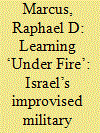

|
|
|
|
|
| Summary/Abstract |
What organisational attributes enhance a military’s ability to effectively adapt on the battlefield? Upon the outbreak of war in July 2014 between Israel and the Palestinian militant group Hamas, the Israel Defense Forces (IDF) encountered an expansive network of tunnels from which Hamas was launching large-scale assaults into Israel. This article illustrates that the IDF’s ability to successfully adapt ‘under fire’ to this battlefield surprise was facilitated by several important attributes related to its organisational learning capacity: a dynamic, action-oriented organisational culture, a flexible leadership and command style, specialised commando units which acted as ‘incubators’ for learning and innovation, and a formal system to institutionalise and disseminate lessons learned.
|
|
|
|
|
|
|
|
|
|
|
|
|
|
|
|
| 15 |
ID:
122548
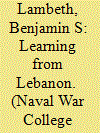

|
|
|
|
|
| Publication |
2012.
|
| Summary/Abstract |
From 12 July until 15 August 2006, the Israel Defense Forces (IDF) waged a
thirty-four-day war against the Iranian terrorist proxy organization Hezbollah
in response to a well-planned raid by a team of Hezbollah combatants from
southern Lebanon into northern Israel. That raid resulted in the abduction of
two IDF soldiers, who had then been taken back into Lebanon for use as hostages.1
Code-named Operation CHANGE OF DIRECTION, the greatly escalated
counteroffensive that the raid prompted has since been widely regarded as the
IDF's most inconclusive combat performance in Israel's history. Waged under
the direction of Prime Minister Ehud Olmert and his minister of defense at the
time, Amir Peretz, the campaign was dominated by precision standoff attacks
by the Israel Air Force (IAF) and by IDF artillery and battlefield rockets, with
no significant commitment of conventional ground troops until the last days of
fighting before a cease-fire went into effect.
|
|
|
|
|
|
|
|
|
|
|
|
|
|
|
|
| 16 |
ID:
094829
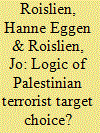

|
|
|
|
|
| Publication |
2010.
|
| Summary/Abstract |
This article is the first to explore the Israel Defense Forces's official statistical data on Palestinian terrorism toward Israeli targets during the al-Aqsa intifada 2000-2004. Focusing the analysis on the logic of terrorist target choice, the article identifies two separate results: First, an unambiguous difference in the form of the attacks contingent on whether they are carried out in the state of Israel or in the Occupied Territories. Second, based on the same distinction, the analysis points out how the attacks are targeted toward distinctively different categories of the Israeli populace. Causes of the results are discussed.
|
|
|
|
|
|
|
|
|
|
|
|
|
|
|
|
| 17 |
ID:
102851
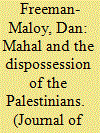

|
|
|
|
|
| Publication |
2011.
|
| Summary/Abstract |
The participation of thousands of overseas volunteers (the Mahal) in Zionist military operations conducted throughout the 1948 war has received insufficient critical attention. Mainly English-speaking World War II veterans recruited by the Zionist movement in the West for their expertise in such needed specializations as artillery, armored warfare, and aerial combat, the Mahal's importance to the military effort far exceeded their numbers. Situating their involvement within the broader historical context of Western support for the Zionist project, this article examines their role within the Haganah and Israel Defense Forces (particularly in aerial and armored units) in operations involving the violent depopulation of Palestinian communities.
|
|
|
|
|
|
|
|
|
|
|
|
|
|
|
|
| 18 |
ID:
119056
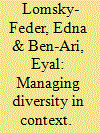

|
|
|
|
|
| Publication |
2013.
|
| Summary/Abstract |
This article is an exploratory study of the factors influencing the management of diversity at the unit level. This management is carried out through ongoing negotiations between troops and commanders and is heavily influenced by the character of the unit within which bargaining takes place and involves the active role of both sides. The most important factors are the unit's structural characteristic (dominant military roles or social composition) and ethos of action (a combat or service orientation). Diversity is thus simultaneously managed as formal policy (intentionally organized) and is self-organized as phenomena emerging at the local level through agreements between the military and individuals and groups serving within it. The analysis is based on qualitative research carried out within the Israel Defense Forces within combat, white-collar, and service units.
|
|
|
|
|
|
|
|
|
|
|
|
|
|
|
|
| 19 |
ID:
167155
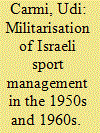

|
|
|
|
|
| Summary/Abstract |
This article discusses the involvement of active service IDF officers in managing central Israeli sport institutions during the early years of the State of Israel. The IDF officers’ activity in sport bodies encouraged the types of sports that served army interests and developed the construction of sport facilities and their maintenance. The involvement of army officers in managing sport institutions in Israel will be explained as part of the military sphere’s penetration to Israel’s managerial sphere in its formative years and as a reflection of the importance given to the IDF as a unifying factor, placed above political considerations.
|
|
|
|
|
|
|
|
|
|
|
|
|
|
|
|
| 20 |
ID:
138744
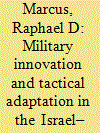

|
|
|
|
|
| Summary/Abstract |
This article highlights a pattern of military adaptation and tactical problem-solving utilized by the Israel Defense Forces (IDF) while engaged in protracted conflict with the Lebanese militant group Hizballah. It discusses the IDF’s recent attempts to institutionalize their historically intuitive process of ad-hoc learning by developing a formal tactical-level mechanism for ‘knowledge management’. The diffusion of this battlefield lesson-learning system that originated at lower-levels of the organization is examined, as well as its implementation and effectiveness during the 2006 Lebanon War. A nuanced analysis of IDF adaptation illustrates the dynamic interplay between both ‘top-down’ and ‘bottom-up’ processes of military innovation.
|
|
|
|
|
|
|
|
|
|
|
|
|
|
|
|
|
|
|
|
|